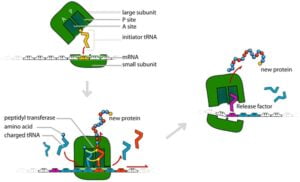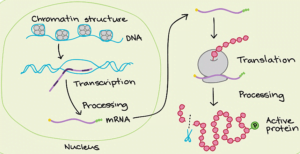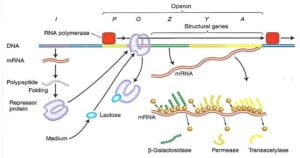1. Incomplete dominance :-
It is a post Mendelian discovery. In the case heterozygous condition of gene results in intermediate phenotype as one allele is only incompletely don’t over the other.
The intermediate of flower colour in the Mirabilis jalapa is a good example to understand incomplete dominance.
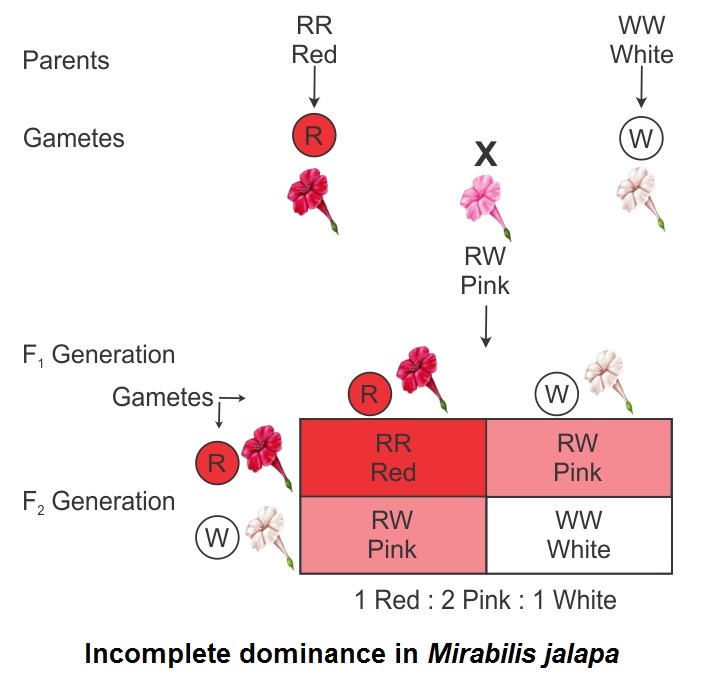
In a cross between true breeding red flowered ( RR ) and true breeding white flowered plants ( ww ), the F₁ ( Rw ) was pink. When the F₁ was self pollinated the F₂ resulted in the following ratios.
Genotype ratio = 1 : 2 : 1
Phenotype ratio = 1 : 2 : 1
Here the genotype ratios were exactly as we would expect in any mendelian monohybrid cross, but the phenotype ratios had changed from the 3 : 1 dominant-recessive ratio.
- Flower colour is snapdragon also shows incomplete dominance.
- Sometimes incomplete dominance is also called Blending inheritance.
2. Co-dominance :-
It is a post Mendelian Discovery. In this case both the contrasting alleles of the genes are independentelly express in heterozygous condition.
Example 1.
Different types of red blood cells that determine ABO blood grouping in human beings.
- ABO blood groups governed by gene I. Gene I has three multiple alleles, there are six different combinations of these three alleles that are possible, and therefore, total of six different genotypes of the human ABO blood types.
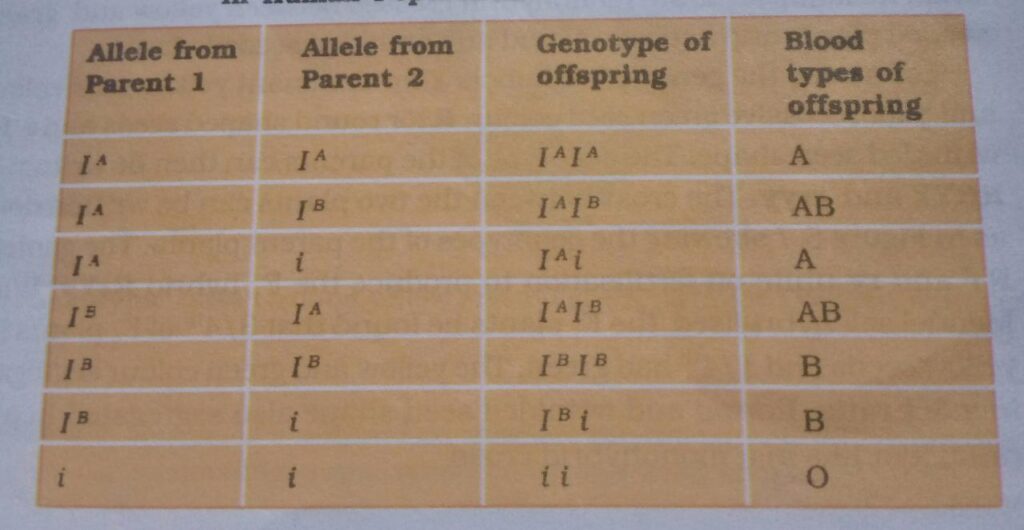
Allele i does not produce any sugar, because humans are diploid organisms, each person possesses any two of the three I gene alleles. Allele A and allele B are completely dominant over i, when allele A and allele B are present togather they both express their own types of sugars. this is because of co-cominance.
Example 2.
colour of skin in cattles

In F₁ generation ( heterozygous ), all cattles will be Roan ( Red and white both colours are present togather ) and In F₂ generation phenotype ratios = 1 Red : 2 Roan : 1 white.
Genotype ratios = 1 Red : 2 Roan : 1 white.
3. Linkage:-
linkage is the persistent associating of genes which without being separated during meiosis are passed on from generation to generation in the same position on their chromosome such genes are linked together and are present on the same chromosome.
• The idea of genetic linkage was first discovered by William bateson, R·C punett & E·R Saunders.
Linkage in Drosophila:-
• The phenomenon of linkage was studied by the scientist T·H· Morgan using the common fruit fly or drosophila melanogaster.
He explain how the process of sexual reproduced variations. He preferred to work on fruit fly or drosophila for the subsequent reasons:-
(1). Could be cultivated easily on a synthetic medium in laboratory.
(2). Exhibit a short lifespan (2 weeks)
(3). Differentiable male and female sexes.
(4). Hereditary variations are of different types.
• Morgan carried out a dihybrid cross between white eyed, yellow bodied females and red eyed, brown bodied males. self crossing of the F₁ generation surprisingly produced an F₂ generation without being in the ratio of 9:3:3:1. The outcome exhibited a divergence from mendel’s dihybrid cross in peas.
• Morgan also carried out a monohybrid cross between white eyed female and red eyed male.

Sex linked inheritance:-
In Mendelian pattern of inheritance, the genes for contrasting characters were located on autosomes but not on the sex chromosomes.
Secondly the result of reciprocal cross is same as normal cross which is not the case with sex linked inheritance.
There are three types of sex linked genes depending upon their association with particular chromosome.
(1). The genes which are located on x-chromosome are called x-linked genes.
(2). The genes which are located on y-chromosome are called y-linked genes or Holandnt genes.
(3). Certain genes are found to occur in both x and y chromosomes. Such genes are called incomplete sex linked genes.
Linkage group:-
All of the genes on a single chromosome are inherited as a group. During cell division they act and move as a unit rather than independently.
The existence of linkage groups is the reason, some traits do not comply with Mendel’s law of independent assortment.
Linkage group in Maize = 10
haploid chromosomes (n) = 10
Drosophila (n=4) = 4
Pea (n=7) = 7
Human(n=23) = 23



